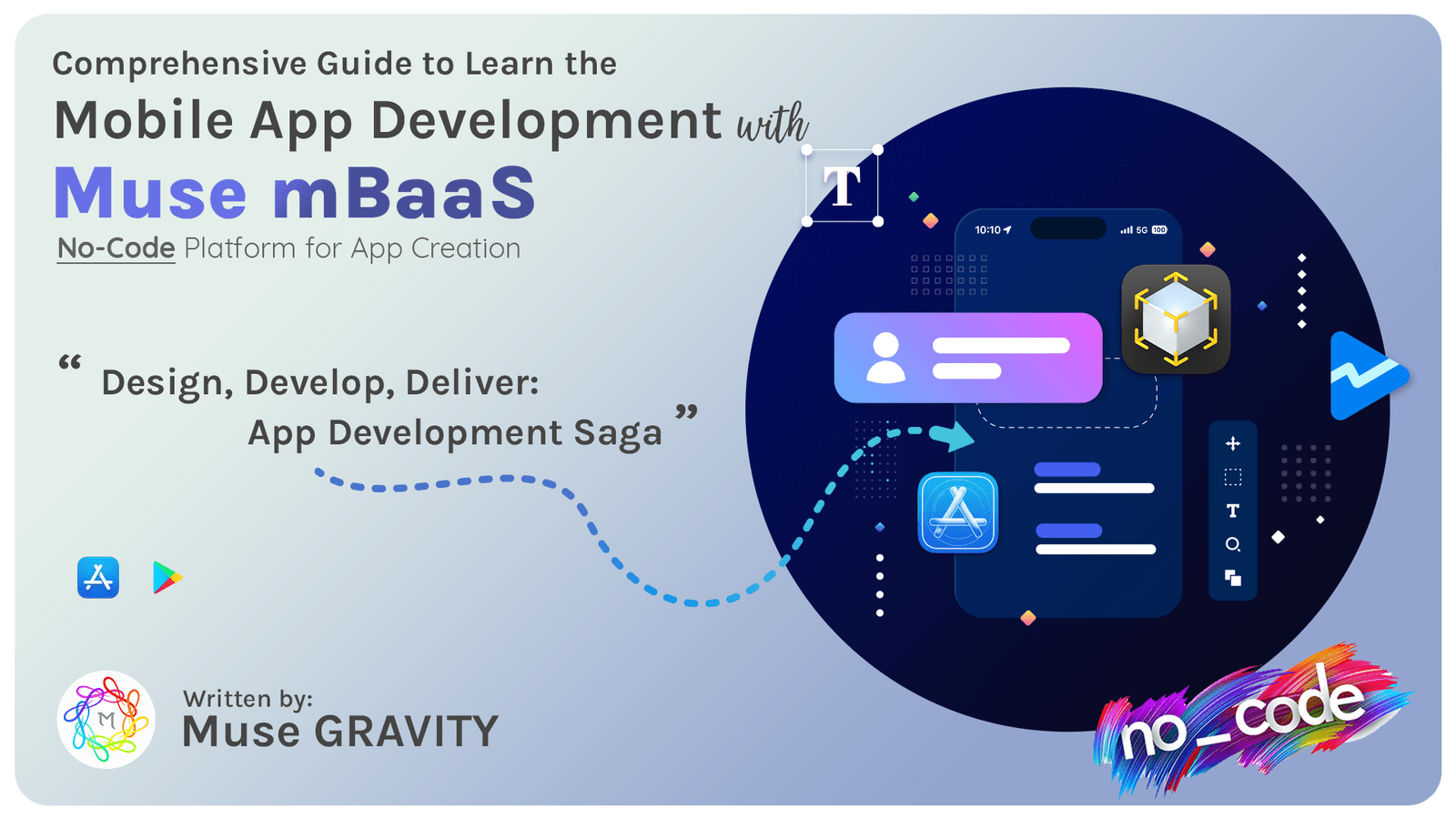
In the rapidly evolving digital landscape, mobile apps have become a cornerstone of technological advancement and user engagement. This comprehensive guide is designed to walk you through the meticulous process of mobile app development, focusing on the methodology both with and without the aid of Muse mBaaS (Mobile Backend as a Service). Whether you're a seasoned developer, an entrepreneur stepping into the mobile app arena, or a curious learner, this guide offers valuable insights into the nuanced world of app creation.
Navigating Traditional Mobile App Development Process
1. Requirement Analysis and Planning :
In the rapidly evolving digital landscape, mobile apps have become a cornerstone of technological advancement and user engagement. This comprehensive guide is designed to walk you through the meticulous process of mobile app development, focusing on the methodology both with and without the aid of Muse mBaaS (Mobile Backend as a Service). Whether you're a seasoned developer, an entrepreneur stepping into the mobile app arena, or a curious learner, this guide offers valuable insights into the nuanced world of app creation.
2. Market Research :
To carve out a niche in the competitive app market, thorough research is indispensable. This step goes beyond mere competitor analysis; it involves understanding market trends, user preferences, and potential gaps that your app could fill. Insightful market research can guide you in fine-tuning your app's features, making it not only functional but also appealing to your target audience. It's about striking a balance between innovation and user expectations, creating a product that resonates with users while standing out in the market.
3. Design :
The design phase is a critical stage where the conceptualized ideas begin to take a tangible form. It's about creating wireframes that lay out the basic structure and flow of the app, ensuring logical and user-friendly navigation. In this phase, the focus is on crafting an engaging and intuitive user interface (UI), considering various factors like color schemes, typography, and element placement. Responsive design is crucial, as the app must function seamlessly across different devices and screen sizes. The design stage sets the foundation for how users will interact with the app, making it a vital aspect of the development process.
4. Coding and Development :
Once the design is finalized, the coding phase begins. This is where developers bring the design to life by writing code for both the front end and back end of the app. The frontend development focuses on creating a visually appealing and interactive user interface, using languages and frameworks suited to the chosen platform (iOS, Android, or cross-platform). Meanwhile, backend development involves setting up servers, creating databases, and ensuring that the app can process and store data efficiently. This phase requires a harmonious collaboration between frontend and backend developers to ensure that all parts of the app work seamlessly together.
5. Testing :
Testing is an indispensable phase in the app development process. This stage involves rigorously checking the app for bugs, usability issues, and overall performance. Different types of testing are conducted, such as unit testing (for individual functions), integration testing (for overall interaction between different parts of the app), and user acceptance testing (to ensure the app meets the user requirements). The goal is to identify and fix any issues before the app reaches the end-users, ensuring a smooth and enjoyable user experience.
6. Deployment :
Deployment is the stage where the app is made public for users. This involves submitting the app to app stores like Google Play Store and Apple App Store, adhering to their specific guidelines and standards. Before this, final checks are conducted to ensure everything is functioning as intended. Once approved by the app stores, the app becomes available for download and use by the target audience.
7. Maintenance and Updates :
The development process doesn't end with the app's launch. Post-deployment, it's essential to maintain the app by regularly updating it with new features, fixing any bugs that arise, and improving performance. Continuous monitoring is crucial to address any operational issues promptly. Regular updates keep the app relevant and can help retain user interest over time.
Developing a mobile app is a multifaceted endeavor that goes beyond just coding and design. It encompasses a thorough understanding of the market, meticulous planning, strategic marketing, and continuous improvement post-launch. Each stage of the process, from conception to deployment and beyond, plays a critical role in the app's success. It's a journey of constant learning, adaptation, and innovation.
Streamlining Mobile App Development process with Muse mBaaS
1. Requirement Analysis and Planning
The cornerstone of any app development, including those using Muse mBaaS, starts with a thorough analysis of what the app needs to achieve. It's about understanding the target market, user needs, and business goals. In this phase, developers map out the key features and functionalities, considering how Muse mBaaS's capabilities can be leveraged to meet these objectives efficiently. This planning stage is crucial in aligning the app's vision with practical execution strategies.
2. Design :
The design phase is where ideas start taking a visual form. This involves creating wireframes for the app's layout and designing the user interface (UI) with a keen focus on user experience (UX). When planning for an app with Muse mBaaS, it's essential to consider how the platform's backend services will integrate with the front end. The goal here is to ensure that the design not only looks appealing but also facilitates smooth interactions between the user and the app's backend functionalities.
3. Backend and Frontend Development with Muse mBaaS :
Muse mBaaS significantly simplifies the backend development process with no code app development by providing ready-to-use backend services like database management, authentication, and server-side logic; Muse mBaaS allows developers to focus more on creating an engaging front end. This integration of backend and frontend development ensures that the app is not only visually appealing but also robust and functional. Developers can use Muse mBaaS to handle complex backend tasks while dedicating more resources to refining the front end, enhancing the overall user experience.
4. Payment Gateway Integration :
A critical component for eCommerce apps is the integration of a secure and reliable payment gateway. With Muse mBaaS, this process can be more straightforward, as the platform may offer built-in support or easier integration options for various payment systems. Ensuring a seamless and secure transaction process is vital for user trust and app credibility.
5. Testing :
Testing is an integral part of the development process, ensuring the app's functionality and performance meet the desired standards. With Muse mBaaS, some aspects of testing, particularly those related to backend stability and performance, can be more efficient. Comprehensive testing, including unit tests, integration tests, and user acceptance testing, is conducted to ensure the app provides a smooth, bug-free user experience.
6. Deployment and Maintenance :
Deploying the app involves making it available on platforms like the Google Play Store and Apple App Store. Muse mBaaS eases this process by managing the backend deployment. Post-launch, the app enters a maintenance phase where it's crucial to monitor its performance, fix any emerging bugs, and release updates for improvements and new features. The use of Muse mBaaS can facilitate ongoing maintenance, especially in managing backend scalability and performance.
Conclusion:
In the world of mobile app development, creating an app is a journey filled with challenges and opportunities, regardless of whether you take the traditional route or use tools like Muse mBaaS. It's a process that combines technical skills, creative thinking, and careful planning.
For traditional app development, it's all about detailed planning from the start, designing an app that users will love, and making sure everything works perfectly through thorough testing. Every step, from understanding what users want to keep the app updated, is key to making an app that's not only useful but also enjoyable to use.
Conversely, using Muse mBaaS simplifies a lot of the technical work, especially on the backend. This means developers can spend more time making the app look good and work well for users. While this makes some parts of the process easier, it still requires a good understanding of app development to ensure the final product is effective.
Both ways show how dynamic and exciting the field of app development is. They highlight the importance of being adaptable, continuously learning, and always focusing on what users need. As technology keeps evolving, the journey of making apps will keep offering new paths to explore and innovate, making it an exciting area to be involved in, whether you're building your first app or are an experienced developer.
No Credit Card Required
Your Questions, answered
















